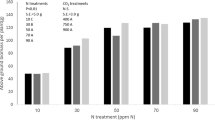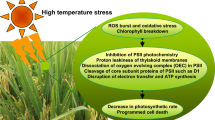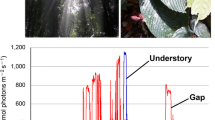Abstract
Although down-regulation of photosynthesis in higher C3 plants exposed to long-term elevated CO2 has been recognized in plants with low sink activity or poor nutrient status, the underlying molecular mechanisms remain unclear. This review covers aspects of rising CO2 on plant productivity in general, and then focuses on photosynthesis, biochemistry (stroma and thylakoid proteins, Rubisco activities and metabolites), and gene expression in tomato plants grown under ambient or elevated CO2. Taking into account these data and the recent discovery that glucose triggers repression of photosynthetic gene transcription, a molecular mechanism is proposed for feedback regulation of photosynthesis under high CO2. Different living organisms such as bacteria, yeast, and mammals have been investigated for the sensing mechanisms of the carbohydrate status of their cells, and this information is used together with some recent data obtained for plants to propose how hexose levels might be sensed in higher plant cells.
Similar content being viewed by others
References
Abbott MS and Bogorad L (1987) Light regulation of genes for the large and small subunits of ribulose bisphosphate carboxylase in tobacco. In: Biggins J (ed) Progress in Photosynthesis Research, Vol 4, pp 527–530. Martinus Nijhoff, Dordrecht
Alderson A, Sabelli PA, Dickinson JR, Cole D, Richardson M, Kreis M, Shewry PR and Halford NG (1991) Complementation of snf1, a mutation affecting global regulation of carbon metabolism in yeast, by a plant protein kinase cDNA. Proc Natl Acad Sc USA 88: 8602–8605
Arp WJ and Drake BG (1991) Increased photosynthetic capacity of Scirpus olneyi after 4 years exposure to elevated CO2. Plant Cell Environ 14: 1003–1006
Bazzaz FA and Fajer ED (1992) Plant life in a CO2-rich world. Sci Am 266: 68–74
Besford RT (1984) Some properties of Ribulose bisphosphate carboxylase extracted from tomato leaves. J Exp Bot 35: 495–504
Besford RT (1990) The Greenhouse Effect: Acelimation of tomato plants growing in high CO2, relative changes in Calvin cycle enzymes. J Plant Physiol 136: 458–463
Besford RT, Withers AC and Ludwig LJ (1984) Ribulose bisphosphate carboxylase and net CO2 fixation in tomato leaves. In: Sybesma (ed) Advances in Photosynthetic Research, Vol 3, pp 773–882. Martinus Nijhoff, Dr W Junk, The Hague
Besford RT, Withers AC and Ludwig LJ (1985) Ribulose bisphosphate carboxylase and photosynthesis during leaf development in the tomato. J Exp Bot 36: 1530–1541
Besford RT, Ludwig LJ and Withers AC (1990) The Greenhouse Effect: Acclimation of tomato plants growing in high CO2, photosynthesis and ribulose-1,5-bisphosphate carboxylase protein. J Exp Bot 41: 925–931
Bowes G (1991) Growth at elevated CO2: Photosynthetic responses mediated through Rubisco. Plant Cell Environ 14: 795–806
Bowes G (1993) Facing the inevitable: Plants and indreasing atmospheric CO2. Annu Rev Plant Physiol Plant Mol Biol 44: 309–332
Brusslan JA and Tobin E (1992) Light-independent developmental regulation of cab gene expression in Arabidopsis thaliana seedlings. Proc Natl Acad Sci USA 89: 7791–7795
Carlson M (1987) Regulation of sugar utilization in Saccharomyces species. J Bacteriol 169: 4873–4877
Cheng CL, Acedo GN, Cristinsin M and Conkling MA (1992) Sucrose mimics the light induction of Arabidopsis nitrate reductase gene transcription. Proc Natl Acad Sci USA 89: 1861–1864
Chory J, Peto C, Feinbaum R, Pratt L and Ausubel F (1989) Arabidopsis thaliana mutant that develops as light-grown plant in the absence of light. Cell 58: 991–999
Curtis PD, Drake BG, Leadley PW, Arp W and Whigahm D (1989) Growth and senescence of plant communities exposed to elevated CO2 concentration on an estuarine marsh. Oecol 78: 20–26
D'Amico L, Valsasina B, Damanati G, Fabbrini S, Nitti G, Bollini R, Ceriotti A and Vitale A (1992) Bean homologs of the mammalian glucose-regulated proteins: Induction by tunicamycin and interaction with newly synthesized seed storage proteins in the endoplasmic reticulum. Plant J 2: 443–455
Delucia EH, Sasek TW and Strain BR (1985) Photosynthetic inhibition after long-term exposure to elevated levels of atmospheric carbon dioxide. Photosynth Res 7: 175–184
Deng XW, Matsui M, Wei N, Wagner D, Chu AM, Feldmann KA and Quail PH (1992) COP1, an Arabidopsis regulatory gene, encodes a protein with both zinc-binding motif and Gβ homologous domain. Cell 71: 791–801
Drake BG and Leadley PW (1991) Canopy photosynthesis of crops and native plant communities exposed to long-term elevated CO2. Plant Cell Environ 14: 853–860
Epstein PN, Boschero AC, Atwater I, Xingeng C and Overbeek PA (1992) Expression of yeast hexokinase in pancreatic betacells of transgenic mice reduces blood-glucose, enhances insulinsecretion, and decreases diabetes. Proc Natl Acad Sci USA 89: 12038–12042
Estelle MA and Somerville CR (1986) The mutants of Arabidopsis. Trends Gen 2: 92–96
Foyer CH, Lescure JC, Lefebvre C, Morot-Gaudry JF, Vincentz M and Vaucheret (1994) Adaptations of photosynthetic electron transport, carbon assimilation and carbon partitioning in transgenic Nicotiana plumbaginifolia plants to changes in nitrate reductase activity. Plant Physiol 104: 171–178
Friedli H, Lötscher H, Oeschger H, Siegenthaler U and Stauffer B (1986) Ice core record of 13C/12C ratio of atmospheric CO2 in the past two centuries. Nature 324: 237–238
German M (1993) Glucose sensing in pancreatic islet beta cells: The key role of glucokinase and the glycolytic intermediates. Proc Nat Acad Sci USA 90: 1781–1785
Graham IA, Denby KJ and Leaver CJ (1994) Carbon catabolite repression regulates glyoxylate cycle gene expression in cucumber. Plant Cell 6: 761–772
Granner D and Pilkis S (1990) The genes of hepatic glucose metabolism. J Biol Chem 265: 10173–10176
Gunderson CA and Wullschleger SD (1994) Photosynthetic acclimation in trees to rising atmospheric CO2: A broader perspective. Photosynth Res 39: 369–388
Halford NG, Vicente-Carbajosa J, Sabelli PA, Shewry PR, Hannappel U and Kreiss M (1992) Molecular analyses of a barley multigene family homologous to the yeast protein kinase gene SNF1. Plant J 2: 791–797
Houghton JT, Callander BA and Varney SK (1992) Climate Change 1992. The supplementary report to the IPCC scientific assessment. Cambridge University Press, New York
Idso SB and Kimball BA (1992) Effects of atmospheric CO2 enrichment on photosynthesis, respiration and growth of sour orange trees. Plant Physiol 99: 341–343
Ishizuka H, Hanamura A, Inada T and Aiba H (1994) Mechanism of the down-regulation of cAMP receptor protein by glucose in Escherichia coli: Role of autoregulation of the crp gene. EMBO J 13: 3077–3082
Jang JC and Sheen S (1994) Sugar sensing in higher plants. Plant Cell 6: 1665–1679
Johnston M and Carlson M 1992 Regulation of carbon and phosphate utilization. In: Jones EW, Pringle JR and Broach JR (eds) The Molecular and Cellular Biology of the Yeast Saccharomyces, pp 193–285. Cold-Spring Harbor Laboratory Press, New York
Keleher C, Redd MJ, Schultz J, Carlson M and Johnson AD (1992) SSN6-Tup1 is a general repressor of transcription in yeast. Cell 68: 709–719
Kimball BA (1983) Carbon dioxide and agricultural yield: An assemblage and analysis of 430 prior observations. Agronomy J 75: 779–788
Krapp A, Quick WP and Stitt M (1991) Ribulose-1,5-bisphosphate carboxylase-oxygenase, other photosynthetic enzymes and chlorophyll decrease when glucose is supplied to mature spinach leaves via transpiration stream. Planta 186: 58–69
Krapp A, Hofmann B, Schäfer C and Stitt M (1993) Regulation of the expression of rbcS and other photosynthetic genes by carbohydrates: A mechanism for the ‘sink regulation’ of photosynthesis? Plant J 3: 817–828
Kuhlemeier C (1992) Transcriptional and post-transcriptional regulation of gene expression in plants. Plant Mol Biol 19: 1–14
Lesage P, Yang X and Carlson M (1994) Analysis of the SIP3 protein kinase. Nucleic Acids Res 22: 597–603
Lundin M, Nehlin JO and Ronne H (1994) Importance of a flanking AT-rich region in target site recognition by the GC box-binding zinc finger protein MIG1. Mol Cel Biol 14: 1979–1985
Mathieu M and Felenbok B (1994) The Aspergillus nidulans CREA protein mediates glucose repression of the ethanol regulon at various levels through competition with the ALCR-specific transactivator. EMBO J 13: 4022–4027.
Matschinsky FM and Ellerman JE (1968) Metabolism of glucose in the islets of Langerhans. J Biol Chem 243: 2730–2736
Melloul D, Ben-Neriah Y and Cerasi E (1993) Glucose modulates the binding of an islet-specific factor to a conserved sequence within the ratI and the human insulin promoters. Proc Natl Acad Sci USA 90: 3865–3869
Micallef BJ, Haskin KA, Vanderveer PJ, Rho KS, Shewmaker CK and Sharkey TD (1995) Altered photosynthesis, flowering, and fruiting in transgenic tomato plants that have an increased capacity for sucrose synthesis. Planta 196: 327–335
Mooney HA and Koch GW (1994) The impact of rising CO2 concentrations on the terrestrial biosphere. Ambio 23: 74–76
Mueckler M (1993) Glucokinase, glucose sensing, and diabetes. Proc Natl Acad Sci USA 90: 784–785
Mullet JE (1988) Chloroplast development and gene expression. Annu Rev Plant Physiol Plant Mol Biol 39: 475–502
Neftel A, Moor E, Oeschger H and Stauffer B (1985) Evidence from polar ice cores for the increase in amospheric CO2 in the past two centuries. Nature 315: 45–47
Newgard CB (1992) Cellular engineering for the treatment of metabolic disorders: Prospects for therapy in diabetes. Biotechnology 10: 1112–1119
Nie GY, Hendrix DL, Webber AN, Kimball BA and Long SP (1995a) Increased accumulation of carbohydrates and decreased photosynthetic gene transcript levels in wheat grown at elevated CO2 concentration in the field. Plant Physiol 108: 975–983
Nie GY, Long SP, Garcia RL, Kimball BA, Lamorte RL, Pinter PJ, Wall GW and Webber AN (1995b) Effects of free-air CO2 enrichment on the development of the photosynthetic apparatus in wheat, as indicated by changes in leaf proteins. Plant Cell Environ 18: 855–864
Norby RJ, Gunderson CA, Wullscleger SD, O'Neill EG and McCracken MK (1992) Productivity and compensatory responses of yellow-poplar trees in elevated CO2. Nature 357: 322–324
Overdieck D (1990) Direct effects of elevated CO2 concentration levels on grass and clover in ‘model ecosystems’. In: Beukema JJ (ed) Expected effects of Climatic Change on Marine Coastal Ecosystems, pp 41–47. Kluwer Academic Publishers, Dordrecht
Pettersson R and Donald AJS (1994) Effects of nitrogen supply on the acclimation of photosynthesis to elevated CO2. Photosynth Res 39: 389–400
Piechulla B and Gruissem W (1987) Diurnal mRNA fluctuations of nuclear and plastid genes in developing tomato fruits. EMBO J 6: 3593–3599
Porter MA and Grodzinski B (1984) Acclimation to high CO2 in bean. Carbonic anhydrase and ribulose bisphosphate carboxylase. Plant Physiol 80: 63–67
Prioul JL and Reyss A (1988) Rapid variations in the content of the RNA of the small subunit of mature tobacco leaves in response to localized changes in light quantity. Relationship between the activity and quantity of enzyme. Planta 174: 488–494
Raynaud D and Barnola LM (1985) An Antarctic ice core reveals CO2: The major uncertainties. Global Biogeochem Cycles 5: 309–314
Rose M, Albig W and Entian KD (1991) Glucose repression in Saccharomyces cerevisiae is directly associated with hexose phosphorylation by hexokinase PI and PII. Eur J Biochem 199: 511–518
Rowland-Bamford AJ, Baker JT, Allen LH and Bowes G (1991) Acclimation of rice to changing atmospheric carbon dioxide concentration. Plant Cell Environ 14: 577–583
Sage RF (1994) Acclimation of photosynthesis to increasing atmospheric CO2: The gas exchange perspective. Photosynth Res 39: 351–368
Saier MH (1991) A multiplicity of potential carbon catabolite repression mechanisms in prokaryotic and eukaryotic microorganisms. New Biol 3: 1137–1147
Sheen J (1990) Metabolic repression of transcription in higher plants. Plant Cell 2: 1027–1038
Sheen J (1994) Feedback control of gene expression. Photosynth Res 39: 427–438
Shorrosh BS and Dixon RA (1992) Molecular characterization and expression of an alfafa protein with sequence similarity to mammalian ERp72, a glucose-regulated endoplasmic reticulum protein containing active site sequences of protein disulphide isomerase. Plant J 2: 51–58
Siegenthaler U and Oeschger H (1987) Biospheric CO2 emissions during the past 200 years reconstructed by deconvolution of the ice core data. Tellus 39: 140–154
Spencer W and Bowes G (1986) Photosynthesis and growth of water hyacinth under CO2 enrichment. Plant Physiol 82: 528–533
Stitt M (1991) Rising CO2 levels and their potential significance for carbon flow in photosynthetic cells. Plant Cell Environ 14: 741–762
Stock J (1993) Phosphoprotein talk. Cur Biol 5: 303–305
Stock JB, Stock AM and Mottonen JM (1990) Signal transduction in bacteria. Nature 344: 395–400
Takahashi T, Tans P and Fung I (1992) Balancing the budget. Carbon dioxide sources and sinks, and the effects of industry. Oceanus 35: 18–28
Tissue DT and Oechel WC (1987) Physiological response of Eriophorum vaginatum to field elevated CO2 and temperature in the Alaska tussock tundra. Ecology 68: 401–410
Tissue DT, Thomas RB and Strain BR (1993) Long-term effects of elevated CO2 and nutrients on photosynthesis and Rubisco in loblolly pine seedlings. Plant Cell Environ 16: 859–865
Trumbly RJ (1992) Glucose repression in the yeast Saccharomyces cerevisiae. Mol Microbiol 6: 15–21
Tzamarias D and Struhl K (1994) Functional dissection of the yeast Cyc8-Tupl transcriptional co-repressor complex. Nature 369: 758–761
Van Oosten JJ and Besford RT (1994) Sugar feeding mimics effect of acclimation to high CO2-rapid down-regulation of RuBisCO small subunit transcripts but not of the large subunit transcripts. J Plant Physiol 143: 306–312
Van Oosten JJ and Besford RT (1995) Some relationships between the gas exchange, biochemistry and molecular biology of photosynthesis during leaf development of tomato plants after transfer to different carbon dioxide concentrations. Plant Cell Environ 18: 1253–1266
Van Oosten JJ, Afif D and Dizengremel P (1992) Long-term effects of a CO2 enriched atmosphere on enzymes of the primary carbon metabolism of spruce trees. Plant Physiol Biochem 30: 541–547
Van Oosten JJ, Dizengremel P, Laitat E and Impens R (1993) Too much of a good thing? Long-term exposure to elevated CO2 decreases carboxylating and photorespiratory enzymes and increases respiratory enzyme activity in spruce. In: Jackson MB and Black CR (eds) Interacting Stresses on Plants in a Changing Climate, pp 185–194. Springer-Verlag, Berlin
Van Oosten JJ, Wilkins D and Besford RT (1994) Regulation of the expression of photosynthetic nuclear genes by high CO2 is mimicked by carbohydrates: A mechanism for the acclimation of photosynthesis to high CO2? Plant Cell Environ 17: 913–923
Van Oosten JJ, Wilkins D and Besford RT (1995) Acclimation of tomato to different carbon dioxide concentrations. Relationships between biochemistry and gas exchange during leaf development. New Phytol 130: 357–367
Vincentz M, Moureaux T, Leydecker MT, Vaucheret H and Caboche M (1993) Regulation of nitrate and nitrite reductase expression in Nicotiana plumbaginifolia leaves by nitrogen and carbon metabolites. Plant J 3: 315–324
von Caemmerer S and Farquhar GD (1981) Some relationships between the biochemistry of photosynthesis and the gas exchange of leaves. Planta 153: 376–387
von Schaewen A, Stitt M, Schmidt R, Sonnewald U and Willmitzer L (1990) Expression of yeast-derived invertase in the cell wall of tobacco and Arabidopsis plants leads to inhibition of sucrose export, accumulation of carbohydrate, and inhibition of photosynthesis, and strongly influences the growth and habitus of transgenic tobacco. EMBO J 9: 3033–3044
Webber AN, Nie GY and Long SP (1994) Acclimation of photosynthetic proteins to rising atmospheric CO2. Photosynth Res 39: 413–425
Wilkins D, Van Oosten JJ and Besford RT (1994) Effects of elevated CO2 on chloroplast proteins in Prunus avium L. Stella. Tree Physiol 14: 769–779
Woodrow IE (1994) Control of steady-state photosynthesis in sunflowers growing in enhanced CO2. Plant Cell Environ 17: 277–286
Woodrow IE and Berry JA (1988) Enzymatic regulation of photosynthetic CO2 fixation in C3 plants. Annu Rev Plant Physiol Plant Mol Biol 39: 533–594
Wong SC (1979) Elevated atmospheric partial pressure of CO2 and plant growth. Oecol 44: 68–74
World Resources Institute (1992). World Resources 1992–93. Oxford University Press, Oxford, UK
Yelle S, Beeson RC, Trudel MJ and Gosselin A (1989a) Acclimation of two tomato species to high atmospheric CO2. I. Sugar and starch concentrations. Plant Physiol 90: 1465–1472
Yelle S, Beeson RC, Trudel MJ and Gosselin A (1989b) Acclimation of two tomato species to high atmospheric CO2. II. Ribulose-1,5-bisphosphate carboxylase/oxygenase and phosphoenolpyruvate carboxylase. Plant Physiol 90: 1473–1477
Ziska LH, Drake BG and Chamberlain S (1990) Long-term photosynthetic response in single leaves of a C3 and C4 salt marsh species grown at elevated atmospheric CO2 in situ. Oecol 83: 469–472
Author information
Authors and Affiliations
Rights and permissions
About this article
Cite this article
Van Oosten, JJ., Besford, R.T. Acclimation of photosynthesis to elevated CO2 through feedback regulation of gene expression: Climate of opinion. Photosynth Res 48, 353–365 (1996). https://doi.org/10.1007/BF00029468
Received:
Accepted:
Issue Date:
DOI: https://doi.org/10.1007/BF00029468




